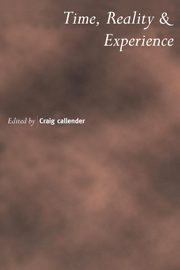Book contents
- Frontmatter
- Contents
- Preface
- Notes on Contributors
- When Time Gets Off Track
- Burbury's Last Case: The Mystery of the Entropic Arrow
- Zeno's Arrow and the Significance of the Present
- Presentism, Ontology and Temporal Experience
- A Presentist's Refutation of Mellor's McTaggart
- Time and Degrees of Existence: A Theory of ‘Degree Presentism’
- McTaggart and the Truth about Time
- On Absolute Becoming and the Myth of Passage
- Time Travel and Modern Physics
- Freedom from the Inside Out
- On Stages, Worms and Relativity
- On Becoming, Cosmic Time and Rotating Universes
- How Relativity Contradicts Presentism
- Can Physics Coherently Deny the Reality of Time?
- Rememberances, Mementos, and Time-Capsules
On Stages, Worms and Relativity
Published online by Cambridge University Press: 05 May 2010
- Frontmatter
- Contents
- Preface
- Notes on Contributors
- When Time Gets Off Track
- Burbury's Last Case: The Mystery of the Entropic Arrow
- Zeno's Arrow and the Significance of the Present
- Presentism, Ontology and Temporal Experience
- A Presentist's Refutation of Mellor's McTaggart
- Time and Degrees of Existence: A Theory of ‘Degree Presentism’
- McTaggart and the Truth about Time
- On Absolute Becoming and the Myth of Passage
- Time Travel and Modern Physics
- Freedom from the Inside Out
- On Stages, Worms and Relativity
- On Becoming, Cosmic Time and Rotating Universes
- How Relativity Contradicts Presentism
- Can Physics Coherently Deny the Reality of Time?
- Rememberances, Mementos, and Time-Capsules
Summary
Abstract
Four-dimensionalism, or perdurantism, the view that temporally extended objects persist through time by having (spatio-)temporal parts or stages, includes two varieties, the worm theory and the stage theory. According to the worm theory, perduring objects are four-dimensional wholes occupying determinate regions of space-time and having temporal parts, or stages, each of them confined to a particular time. The stage theorist, however, claims, not that perduring objects have stages, but that the fundamental entities of the perdurantist ontology are stages. I argue that considerations of special relativity favor the worm theory over the stage theory.
Introduction
Recent work on persistence over time has produced a more finegrained inventory of views than we had a few years ago. Although there are still two major rival accounts of persistence on the market: three-dimensionalism (3D, endurantism) and four-dimensionalism (4D, perdurantism), distinct varieties of each view have now been identified. For example, philosophers who think that ordinary material objects endure—that they are wholly present at all times at which they exist—now explicitly include those who prefer to run this position together with a certain theory of time, namely presentism (roughly, the view that only the present exists), and those who deny this link between the theory of persistence and the philosophy of time. Similarly, four-dimensionalists who think objects perdure—persist by having different temporal parts at different times—comprise those who think that this position presupposes eternalism (the idea that all moments of time are on the same ontological footing) as well as those who argue against this connection.
- Type
- Chapter
- Information
- Time, Reality and Experience , pp. 223 - 252Publisher: Cambridge University PressPrint publication year: 2002
- 4
- Cited by



